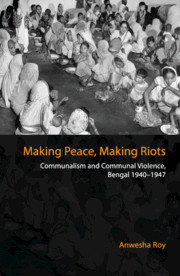Book contents
- Frontmatter
- Frontmatter
- Contents
- Maps and Figures
- Acknowledgements
- Abbreviations
- Glossary
- Introduction
- 1 The Dacca Riot, 1941
- 2 Famine 1943 – Towards a Hardening of Community Identities
- 3 From Community to Communal: The Bengal Secondary Education Bill and the Idea of Pakistan
- 4 The Great Calcutta Killing, August 1946
- 5 Noakhali Riots, October 1946
- 6 A Test of Faith: Gandhi in Noakhali and Calcutta 1946–47
- Concluding Remarks
- Appendix 1
- Appendix 2
- Appendix 3
- Appendix 4
- Bibliography
- Index
2 - Famine 1943 – Towards a Hardening of Community Identities
Published online by Cambridge University Press: 23 October 2018
- Frontmatter
- Frontmatter
- Contents
- Maps and Figures
- Acknowledgements
- Abbreviations
- Glossary
- Introduction
- 1 The Dacca Riot, 1941
- 2 Famine 1943 – Towards a Hardening of Community Identities
- 3 From Community to Communal: The Bengal Secondary Education Bill and the Idea of Pakistan
- 4 The Great Calcutta Killing, August 1946
- 5 Noakhali Riots, October 1946
- 6 A Test of Faith: Gandhi in Noakhali and Calcutta 1946–47
- Concluding Remarks
- Appendix 1
- Appendix 2
- Appendix 3
- Appendix 4
- Bibliography
- Index
Summary
What is happening is no ordinary famine – but a complete disintegration of social life – or a putrefaction of all social life. Villages are wiped out. The boatmen and fishermen communities are no more in many places. The poor peasant is driven from the land with his family … mothers sell children. Young girls sell themselves to the lust of men who give them venereal diseases and aid hunger in killing them. Parental love, filial duty, conjugal affection, love of village and home – all the precious heritage of man acquired within the course of centuries, has disappeared for thousands whose only thought is about a morsel of decent food.
That is what Bengal is – abominable degradation of human beings, a blot on the Indian national movement – an indictment of selfish bureaucratic rule in this country.
‘Collapse of Social Life’, People's War, 7 November 1943There could not be a better description of the impact of the famine of 1943–44 in Bengal, one of the most horrifying experiences in the history of the province. Also known as ‘Panchasher Manwantar’, it shook Bengali society to its very roots. There have been numerous studies on the causes of the famine of 1943. However, there is a need to revisit the famine in the light of the deep impact that it had on communal politics in Bengal. The near total absence of food as a result of a man-made catastrophe set in motion a chain reaction. The chapter has been divided into two sections. The first section studies in detail the impact of hunger on Bengali society in 1943–44. Widespread destitution, first due to the War and then the unavailability of food and other basic necessities like clothing, kerosene and cooking oil, led to a downward spiral in the social and moral order. As family and kinship ties failed to secure survival, the community association alone kept the shattered people together. The second section links up this terrible experience to the complete dependence of famine victims on relief. A detailed analysis of the nature and complexities of relief/rehabilitation is drawn up to show how communal politics insinuated itself deep into the relief process. This, in turn, shaped the social and political developments in Bengal in subsequent years.
- Type
- Chapter
- Information
- Making Peace, Making RiotsCommunalism and Communal Violence, Bengal 1940–1947, pp. 68 - 103Publisher: Cambridge University PressPrint publication year: 2018



